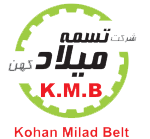The closed circuit timing belt is used in all kinds of machines with precise and controlled movements and at high speed, and it works without problems in the temperature range of -25 to +80 degrees Celsius. It has excellent resistance to oil, grease and fat. Closed circuit timing belts can have different materials such as plastic, polyurethane, rubber, etc
Closed circuit rubber timing belt
Due to being resistant to heat and having more flexibility than polyurethane closed circuit belts, they are suitable for use in all kinds of industrial equipment. The components of the time belt are made of polyurethane, and the twisted wires in them are used to increase the tensile strength. Also, different standard production widths and various pitches of closed circuit timing belts increase the possibility of choice.
Rubber timing belt
It is made of rubber compounds and cotton fibers. In closed-circuit timing belts, the rubber closed-circuit belt with various inch and metric steps causes diversity in construction and uses. Polyurethane closed circuit timing belts are made of thermoplastic polyurethane with steel wires and are suitable for power transmission systems. Polyurethane closed circuit timing belts do not need maintenance. Also, these closed circuit timing belts are resistant to wear, oil and grease.
Closed circuit timing belt
Made of thermoplastic polyurethane, they are usually installed on the rotating mechanisms of a power transmission system, and this type of belt often plays a very important role in the smooth operation of internal combustion engines, where they connect the crankshaft to the camshaft for precise alignment (timing ) between these two key components while maintaining a variable but constant rotation, and on almost all engines manufactured before the last 20 years, timing belts are uniformly made of thick belts of hard, flexible rubber. And to this day, tough rubber materials remain an ideal solution for closed-circuit belts in terms of performance in order to maintain tension between critical moving parts in the short to medium term.
The main advantage of closed circuit belts
This is because the thermoplastic construction makes it much more durable and far less prone to needing periodic replacement than material belts, and the closed-circuit timing is much quieter, which in the rare event that it fails catastrophically can cause damage. In addition, the timing belt tensioners are controlled by engine oil pressure, which means that maintaining this pressure at the correct level of the rod is always more important, whereas water pump pressure is usually what affects performance. The fit determines the tension, which is why it’s often recommended that you replace your water pump at the same time you install a new timing belt.
However, over longer periods, the rubber compounds of the closed circuit belt are prone to degradation through continuous exposure to excessive engine heat and contact with aggressive substances such as engine oil, and the result of this prolonged exposure is usually loss. Providing optimal tension, which in turn adversely affects the precise opening and closing timing of the engine’s valves, necessitates the eventual replacement of a cambelt in order to restore the engine’s shaky performance to its former peak in the closed circuit timing belt. .
Timing belts provide a wide range of related functions in all types of power transmission systems other than internal combustion engines. And common examples seen in everyday manufacturing and industrial processes include conveyor belts and linear positioning belts, and various configurations of closed circuit belts are used in a wide variety of products and processes.

